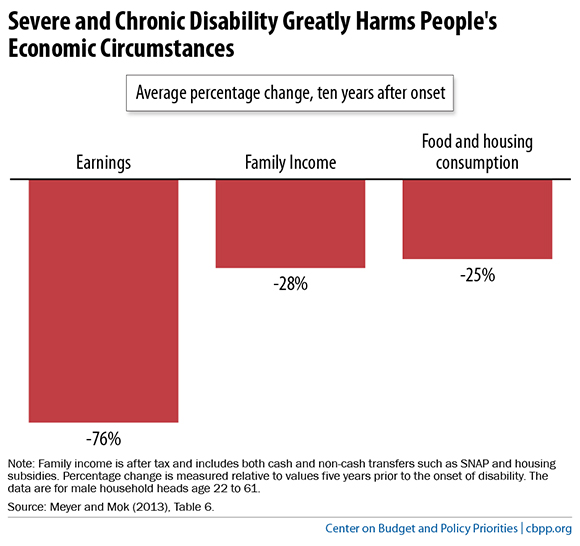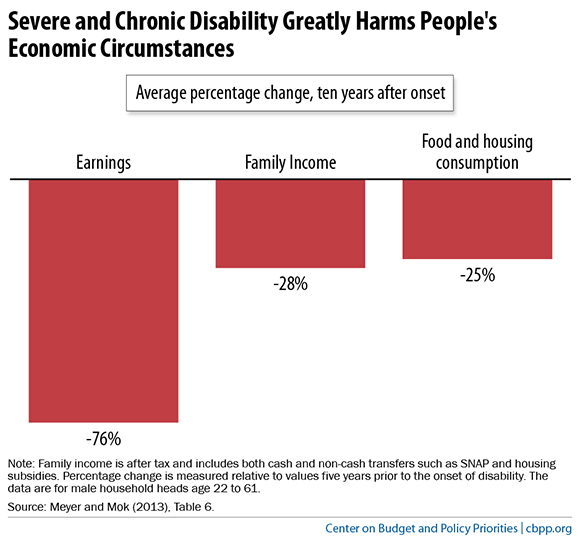
The Social Security Disability Fund is a crucial part of Social Security that provides support to people with serious disabilities and medical conditions. In 2016, the fund will need to be replenished to continue protecting people with disabilities and their families at the same levels as in the past. Failure to act will result in a 20 percent cut in assistance for the disabled next year.
Almost 11 Million People Receive Disability Benefits, Including 1.8 Million Children
Disabilities can greatly reduce individuals’ earning potential. The below graph from the Center on Budget and Policy Priorities shows that ten years after the onset of a disability, workers’ earnings fall on average 76 percent.

Such a dramatic drop in income can decimate a family’s savings, including retirement savings, and make it impossible to pay back a home mortgage or car payments. Social Security Disability payments provide the average disabled worker only $1,165 per month. The benefit protects against the worst kinds of financial devastation
Social Security Disability Beneficiaries Must Meet Strict Criteria
The individuals receiving Social Security disability benefits must have spent at least a quarter of their lives working, including five of the last ten years of their lives. Additionally, they must have a condition expected to last at least 12 months that is serious, and they must be unableto perform “substantial gainful activity.” Almost two-thirds of applicants are denied benefits, even after reconsideration and appeals.
Overwhelmingly, the individuals receiving Social Security disability are older – 70 percent are over age 50 – and they have serious physical and/or mental impairments. (Note: As these individuals reach Social Security’s full retirement age, they are switched from Social Securitydisability to Social Security retirement insurance.) These individuals are on average three to six times more likely to die than other Americans in their age group.
We Knew This Was Coming
The Social Security Disability Fund is funded through the Social Security payroll tax. Currently, workers and employers each pay a 0.9 percent tax on annual earnings up to $118,500 towards the disability fund.
Experts warned as far back as 1995 that without action the fund would need to be replenished in 2016. Inaction over the course of the past 20 years has put support for disabled Americans at risk.
As expected, a number of long-term demographic factors have put pressure on the disability fund, including population growth, an aging of the population, women’s increasing participation in the workforce since the 1970’s, and the increase in the Social Security retirement age.
Several proposals have been floated to avert the 20 percent reduction in benefit payments that will be necessary if Congress fails to act. Some have been made before, including proposals to reallocate revenue from the Social Security Retirement Fund into the Disability Fund for a limited amount of time. Such a change has occurred multiple times in the past (most recently in 1994). Shifting revenue temporarily again could replenish the disability trust fund for several years.
Other more controversial proposals could reduce the amount beneficiaries and their families receive. For example, more gradually reducing benefits if beneficiaries are able to work has been proposed as a cost-saving measure. Currently, beneficiaries making more than $1,090 per month can be cut off from the program abruptly. According to the Center on Budget and Policy Priorities, however, the savings from such a plan would be small and increase the administrative costs of the overall program. Additionally, the design of the scale could discourage beneficiaries from seeking out work.
The Social Security Disability Fund (as well as the Retirement Fund in 2033) will require replenishment, if we are going to keep our commitment to current and future beneficiaries. But there are very straightforward ways – including reallocation of revenue in the short-term and increases to Social Security revenue in the longer-term through such things as lifting that cap on income subject to payroll taxes – that can ensure the continuation of these programs for decades without reducing benefits.
Congress should stop dragging its feet and act now to responsibly address a problem it’s been staring at for 20 years. For millions of Americans, these earned-benefit programs are crucial lifelines that ensure a basic sense of economic security and dignity.
Join us in defending the truth before it’s too late
The future of independent journalism is uncertain, and the consequences of losing it are too grave to ignore. To ensure Truthout remains safe, strong, and free, we need to raise $31,000 in the next 48 hours. Every dollar raised goes directly toward the costs of producing news you can trust.
Please give what you can — because by supporting us with a tax-deductible donation, you’re not just preserving a source of news, you’re helping to safeguard what’s left of our democracy.